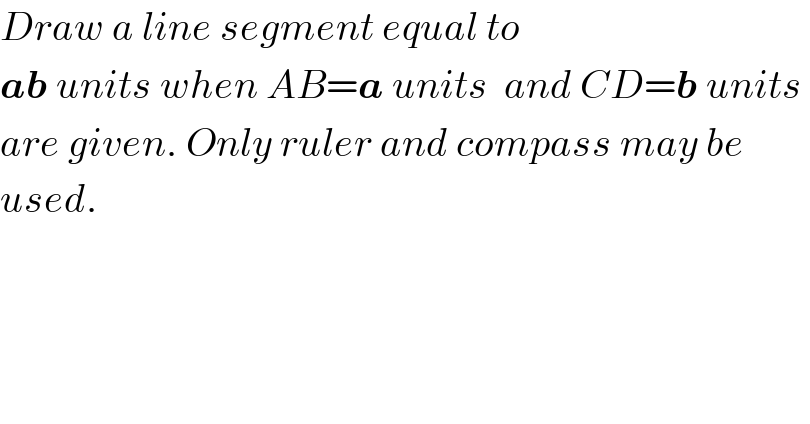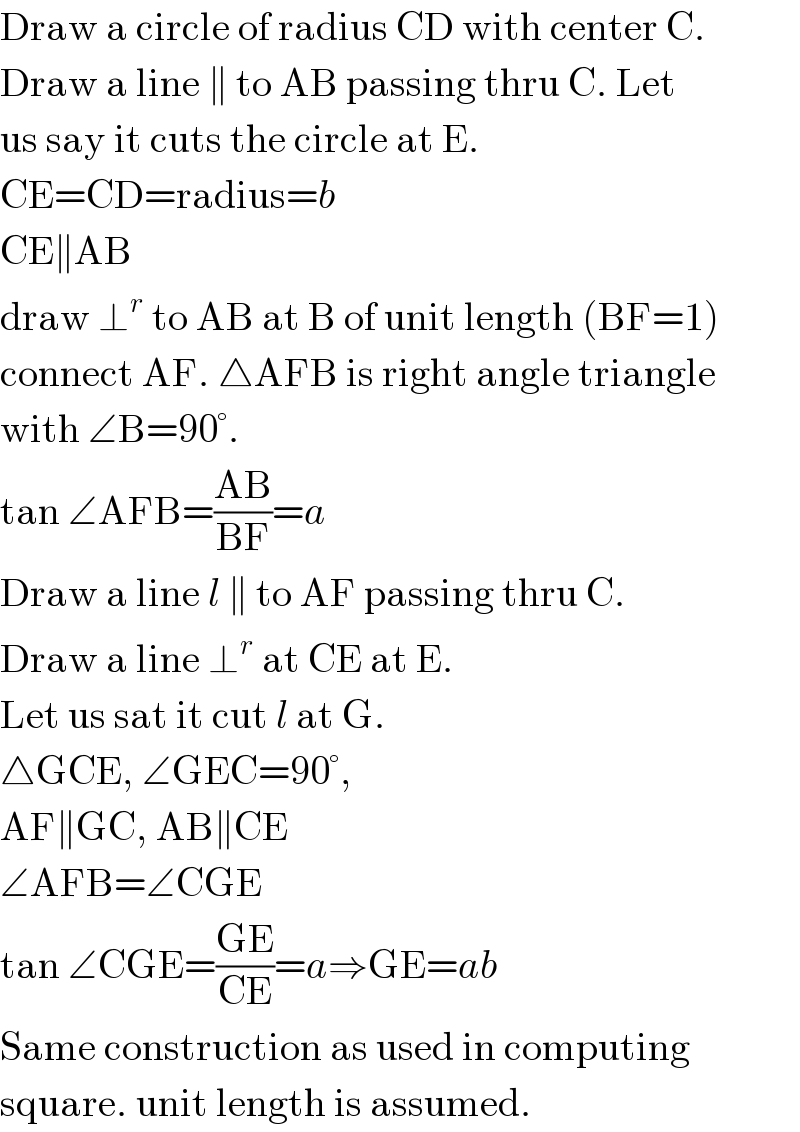Question Number 3647 by Rasheed Soomro last updated on 17/Dec/15

$${Draw}\:{a}\:{line}\:{segment}\:{equal}\:{to} \\ $$$$\boldsymbol{{ab}}\:{units}\:{when}\:{AB}=\boldsymbol{{a}}\:{units}\:\:{and}\:{CD}=\boldsymbol{{b}}\:{units}\: \\ $$$${are}\:{given}.\:{Only}\:{ruler}\:{and}\:{compass}\:{may}\:{be} \\ $$$${used}. \\ $$
Commented by prakash jain last updated on 17/Dec/15

$$\mathrm{Draw}\:\mathrm{a}\:\mathrm{circle}\:\mathrm{of}\:\mathrm{radius}\:\mathrm{CD}\:\mathrm{with}\:\mathrm{center}\:\mathrm{C}. \\ $$$$\mathrm{Draw}\:\mathrm{a}\:\mathrm{line}\:\parallel\:\mathrm{to}\:\mathrm{AB}\:\mathrm{passing}\:\mathrm{thru}\:\mathrm{C}.\:\mathrm{Let} \\ $$$$\mathrm{us}\:\mathrm{say}\:\mathrm{it}\:\mathrm{cuts}\:\mathrm{the}\:\mathrm{circle}\:\mathrm{at}\:\mathrm{E}. \\ $$$$\mathrm{CE}=\mathrm{CD}=\mathrm{radius}={b} \\ $$$$\mathrm{CE}\parallel\mathrm{AB} \\ $$$$\mathrm{draw}\:\bot^{{r}} \:\mathrm{to}\:\mathrm{AB}\:\mathrm{at}\:\mathrm{B}\:\mathrm{of}\:\mathrm{unit}\:\mathrm{length}\:\left(\mathrm{BF}=\mathrm{1}\right) \\ $$$$\mathrm{connect}\:\mathrm{AF}.\:\bigtriangleup\mathrm{AFB}\:\mathrm{is}\:\mathrm{right}\:\mathrm{angle}\:\mathrm{triangle} \\ $$$$\mathrm{with}\:\angle\mathrm{B}=\mathrm{90}°. \\ $$$$\mathrm{tan}\:\angle\mathrm{AFB}=\frac{\mathrm{AB}}{\mathrm{BF}}={a} \\ $$$$\mathrm{Draw}\:\mathrm{a}\:\mathrm{line}\:{l}\:\parallel\:\mathrm{to}\:\mathrm{AF}\:\mathrm{passing}\:\mathrm{thru}\:\mathrm{C}. \\ $$$$\mathrm{Draw}\:\mathrm{a}\:\mathrm{line}\:\bot^{{r}} \:\mathrm{at}\:\mathrm{CE}\:\mathrm{at}\:\mathrm{E}. \\ $$$$\mathrm{Let}\:\mathrm{us}\:\mathrm{sat}\:\mathrm{it}\:\mathrm{cut}\:{l}\:\mathrm{at}\:\mathrm{G}. \\ $$$$\bigtriangleup\mathrm{GCE},\:\angle\mathrm{GEC}=\mathrm{90}°, \\ $$$$\mathrm{AF}\parallel\mathrm{GC},\:\mathrm{AB}\parallel\mathrm{CE} \\ $$$$\angle\mathrm{AFB}=\angle\mathrm{CGE} \\ $$$$\mathrm{tan}\:\angle\mathrm{CGE}=\frac{\mathrm{GE}}{\mathrm{CE}}={a}\Rightarrow\mathrm{GE}={ab} \\ $$$$\mathrm{Same}\:\mathrm{construction}\:\mathrm{as}\:\mathrm{used}\:\mathrm{in}\:\mathrm{computing} \\ $$$$\mathrm{square}.\:\mathrm{unit}\:\mathrm{length}\:\mathrm{is}\:\mathrm{assumed}. \\ $$
Commented by Rasheed Soomro last updated on 19/Dec/15

$$\mathcal{T}{h}\alpha{n}\Bbbk\mathcal{S}! \\ $$$${First}\:\mathcal{I}\:{will}\:{try}\:{my}\:{own}\:{then}\:\mathcal{I}\:{will}\:{read} \\ $$$${your}\:{answer}\:\left({in}\:{order}\:{to}\:{train}\:{myself}\right). \\ $$
